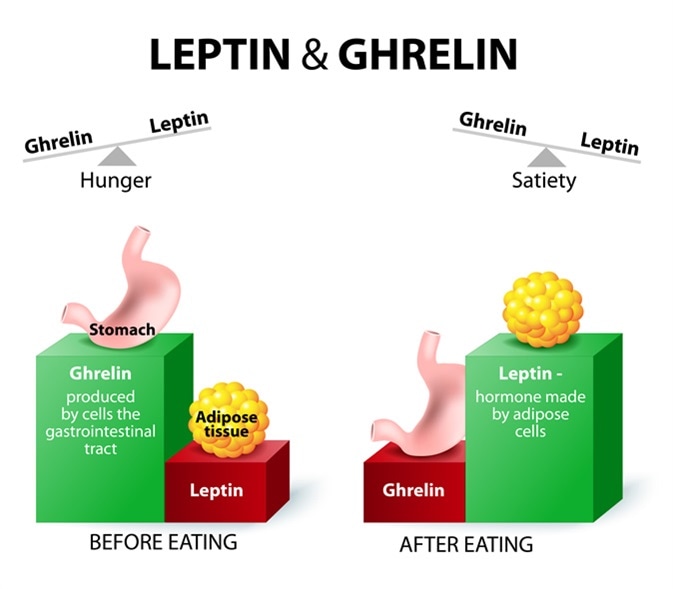Ghrelin and Leptin

Ghrelin and leptin are two hormones which are of great interest in appetite regulation. Leptin is commonly considered to be anorexigenic (i.e. appetite suppressant) while ghrelin is orexigenic (i.e. appetite stimulant).
They are secreted in a reciprocal rhythm, influenced by the neuropeptide Y (NPY) system in the hypothalamus which is acted upon by these afferent hormones. This highly specific system shows rhythmic secretion, imparting in turn the same pattern to the expression of appetite and feeding behavior.

Leptin and Ghrelin on Body Weight
Leptin inhibits ghrelin in two ways; it reduces ghrelin secretion by gastric cells, and suppresses the expression of ghrelin receptors in the NPY system, therefore preventing the stimulation of feeding behaviors by the latter. This effect is postulated to constitute the major feedback loop between the organs of eating and the hypothalamus which maintains body weight.
When this loop is disrupted at any point, either in terms of timing, duration, or magnitude of feedback impulse signalling, hypothalamic loss of feeding is lost, resulting in obesity. Leptin also increases the rate of thermogenesis and thus promotes weight maintenance.
Ghrelin, on the other hand, stimulates feeding and results in obesity. It is produced in the stomach and also in the hypothalamic subparaventricular zone, which has an appetite-stimulant action. Ghrelin levels rises before a meal, and goes down after meals.
Moreover, ghrelin levels fluctuate in accordance with changes in energy reserves in the body. Thus ghrelin is episodic in secretion, but the amplitude depends upon the feeding status. This hormone is also involved in the short-term regulation of human appetite.
Experimentally, even when the same type of diet is fed to different rodents, two categories are rapidly formed: the first is obesity-prone and starts to put on weight rapidly, whereas the second group shows a static weight. This can be explained by the fact that the first group alone shows high leptin levels, with low ghrelin levels, possibly caused by the former. Conversely, the other group has no alteration in the secretion of both hormones.
Hypothalamic Restraint by Leptin
In another study, leptin lowering was associated with high levels of ghrelin secretion, but there was a centrally-operating suppression of the expected appetite drive despite increased ghrelin. Ghrelin secreted in the stomach mucosa circulates to the brain and crosses the blood-brain-barrier. It acts together with locally secreted ghrelin in the hypothalamus to stimulate the NPY and other neurons in the ARC-PVN nucleus to stimulate appetite. This can be inhibited by Y1 receptor antagonists acting on the NPY neurons.
Leptin acts to reduce the synthesis, release, and biological actions of NPY in the ARC-PVN neuronal system via long leptin receptor activation. Yet leptinopenic mice (i.e. those with low levels of leptin) failed to develop a good appetite, though their ghrelin levels rose. Thus the hypothalamic restraint exercised by leptin overrides even a strong peripheral afferent signal by ghrelin.
Actions of Ghrelin
There are several notable actions that ghrelin has on a human body:
- It regulates the blood glucose levels through reduced insulin secretion and by regulating the synthesis and breakdown of glucose and glycogen
- It reduces heat production to conserve energy
- It reduces sympathetic activity
- It promotes the differentiation and fusion of muscle fibers
- It plays a role in regulating bone growth through osteoblast differentiation and proliferation, a role in bone protection, and has an opposing role to leptin in bone metabolism
- It is also highly expressed in metastatic cancer cells
When the body is in positive energy balance, ghrelin levels go down, and vice versa in cases of fasting or anorexia nervosa. Leptin does exactly the opposite; however, it is not clear whether the primary stimulus is the calorie deprivation or the lower energy stores.
In the anorexic eating disorders, the ghrelin levels are chronically raised, which may be due to the negative state of the body’s energy, and are meant to stimulate the appetite to increase body fat percentage. Nevertheless, it may also mean that such patients are unresponsive to ghrelin.
References
- http://jn.nutrition.org/content/135/5/1331.full
- https://www.ncbi.nlm.nih.gov/pubmed/17212793
- https://www.ncbi.nlm.nih.gov/pmc/articles/PMC4049314/
- https://www.ncbi.nlm.nih.gov/pmc/articles/PMC3522761/
- https://www.ncbi.nlm.nih.gov/pmc/articles/PMC2814160/
- https://www.ncbi.nlm.nih.gov/pmc/articles/PMC3400908/
Further Reading
- All Ghrelin Content
- Ghrelin – What is Ghrelin?
- What Does Ghrelin Do?
- Ghrelin and Diseases
- Ghrelin and the Gastrointestinal Tract
Last Updated: Aug 23, 2018

Written by
Dr. Liji Thomas
Dr. Liji Thomas is an OB-GYN, who graduated from the Government Medical College, University of Calicut, Kerala, in 2001. Liji practiced as a full-time consultant in obstetrics/gynecology in a private hospital for a few years following her graduation. She has counseled hundreds of patients facing issues from pregnancy-related problems and infertility, and has been in charge of over 2,000 deliveries, striving always to achieve a normal delivery rather than operative.
Source: Read Full Article